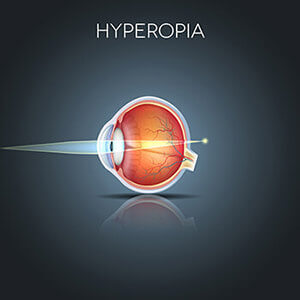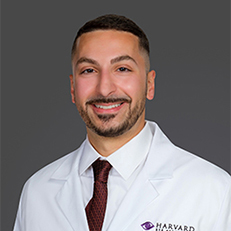LASIK Eye Surgery in Orange County, CA

Understanding LASIK
LASIK (Laser-Assisted In-Situ Keratomileusis) is a laser surgery that can correct most cases of imperfect vision due to nearsightedness, farsightedness, or astigmatism. With monovision or blended vision correction, LASIK can also correct presbyopia (the need for reading glasses).
In this procedure, the surface layer of corneal tissue is folded back from its usual position. The laser then gently reshapes the corneal surface and the surface layer is placed back in its original position where it bonds naturally.

The LASIK procedure takes about 5 minutes and is performed on an outpatient basis. Most patients say they have no pain with LASIK and most can return to work the next day.
Learn more about LASIK by scheduling a free, no-obligation LASIK evaluation with us. During your appointment, you will meet with one of our Orange County LASIK doctors, they will evaluate your eyes, and determine if you are a candidate for LASIK surgery.
What Eye Conditions does LASIK correct?
How do the Eyes Focus?
The eyes focus by bending incoming light rays to meet at a single point. Ideally, this single point lands directly on the central point of the retina for clear, sharp images. If the focal point is behind the retina or in front of the retina, the image on the retina will not be fully formed and is interpreted by the brain as being blurred.
This is a refractive error. This is very much like focusing a projector onto a blank movie screen. If the projection is too close or too far from the screen, the images are blurred. When set at the correct distance, you may enjoy the show!
Refractive errors that may be corrected with LASIK include:
- Nearsightedness
- Farsightedness
- Astigmatism
Nearsightedness (Myopia)
 Nearsighted individuals typically have problems seeing well at a distance. The nearsighted eye is usually longer than a normal eye and its cornea may also be steeper. Therefore, when light passes through the cornea and lens it is focused in front of the retina.
Nearsighted individuals typically have problems seeing well at a distance. The nearsighted eye is usually longer than a normal eye and its cornea may also be steeper. Therefore, when light passes through the cornea and lens it is focused in front of the retina.
This will make distant images appear blurred. LASIK, PRK, implantable contact lenses, and other methods can be used to correct nearly all levels of nearsightedness.
Farsightedness (Hyperopia)
 Farsighted individuals typically develop problems reading up close before the age of 40. The farsighted eye is usually slightly shorter than a normal eye and may have a flatter cornea.
Farsighted individuals typically develop problems reading up close before the age of 40. The farsighted eye is usually slightly shorter than a normal eye and may have a flatter cornea.
Therefore, when light passes through the cornea and lens it is focused behind the retina. Near objects require even greater focusing power to be seen clearly and therefore blur more easily. LASIK, PRK, and other methods can be used to help correct farsightedness.
Astigmatism
 Individuals with astigmatism typically experience vision where the images they see seem to be blurred or shadowed. This is caused by asymmetric steepening of the cornea or natural lens, which causes light to be focused unevenly on the retina.
Individuals with astigmatism typically experience vision where the images they see seem to be blurred or shadowed. This is caused by asymmetric steepening of the cornea or natural lens, which causes light to be focused unevenly on the retina.
Astigmatism can accompany any form of refractive error and is very common. LASIK, PRK, and other methods can be used to help correct astigmatism.
Presbyopia: Not a Refractive Error
 Presbyopia is a condition that typically becomes noticeable for most people around age 45.
Presbyopia is a condition that typically becomes noticeable for most people around age 45.
In children and young adults, the lens inside the eye can easily focus on distant and near objects. With age, the lens loses its ability to focus adequately.
Although presbyopia is not completely understood, it is thought that the lens and its supporting structures lose the ability to make the lens longer during close vision effort. To compensate, affected individuals usually find that holding reading material further away makes the image clearer.
Ultimately, aids such as reading glasses are typically needed by the mid-40s. Besides using reading glasses, presbyopia can be corrected in a number of ways. Some options include monovision with LASIK or PRK surgery, accommodating lens implants, and multifocal contact lenses.
When you have an eye exam at Harvard Eye Associates, your doctor will measure your eyes and determine whether you are nearsighted or farsighted and whether you have astigmatism and/or presbyopia. Based on the results from your eye examination, your eye doctor will discuss all the treatment options that are available to you along with the risks, benefits, and alternatives of each treatment.
Contact us today to schedule a free LASIK evaluation with one of our LASIK doctors.
Common LASIK Questions

How long does LASIK take? Does LASIK hurt?
The actual LASIK procedure takes about 5 minutes per eye. Most people will feel a sensation of pressure during the procedure, but because the eyes are numbed with eye drops before surgery, most patients do not experience any pain.
How long is LASIK recovery?
Even though some patients begin seeing better immediately after the procedure, you will need to have someone drive you home after surgery. For the remainder of the day, you should plan to rest at home. Most patients wake up the next day with clear vision and are able to return to work within 24-48 hours after their LASIK procedure.
Are there any risks with undergoing LASIK surgery?
Like any surgery, there are risks to LASIK. When performed by an experienced LASIK surgeon using advanced technologies, those risks will be greatly minimized. You should, however, be aware of some of the potential complications. Your doctor will review the risks, benefits, and alternatives to LASIK surgery during your consultation.
Will I ever need eyeglasses after LASIK?
Maybe. LASIK is a procedure that changes the shape of the cornea to allow light to focus properly on the retina. However, as you age, the natural lens in your eye may start to lose flexibility. This is called presbyopia and it occurs to most people around the age of 45. With a loss in flexibility, you may not be able to read close-up and may need reading glasses for daily tasks.
Monovision treatment may be an option for patients wishing to reduce their dependency on reading glasses after surgery. Monovision is where one eye is corrected for distance vision and one eye is corrected for close-up vision. Your eye doctor can determine if this is an appropriate option for you during your consultation.
Can anyone who wears glasses have LASIK?
Unfortunately no. Some people do not have the correct eye anatomy and eye health for LASIK. The only way to know if LASIK is right for your eyes is to be evaluated by a LASIK surgeon.
Are there any LASIK alternatives?
Yes. For patients who have thin corneas or other eye issues, our Orange County, CA, LASIK experts can recommend and perform other vision correction treatments that can produce similar vision results as LASIK. These options will be discussed in detail with you during your free LASIK evaluation at our office.
How can I choose the right LASIK doctor in Orange County?
Ask questions – no matter how insignificant they may seem! Choose an experienced surgeon who will provide you with information about the procedures which are an appropriate candidate for, review the risks benefits and alternatives for those procedures, personally oversee every step of the process and take the time to answer all of your questions. Make sure you know everything you can about the procedure being performed.
Have more questions? Learn more about LASIK in Orange County by scheduling your free LASIK Evaluation at Harvard Eye Associates.
If you are experiencing an eye emergency or other urgent matters, please call our office immediately.











